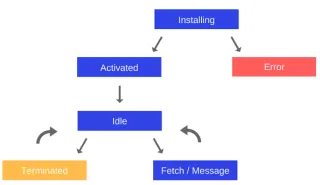
ECMAScript 6与Es5的等价
ECMAScript 6与Es5的等价,可以说这是让你快速学习从ES5到ES6的方式,如果你是从一开始就是学习ES6的,现在要维护别人的ES5代码,这个文档也非常值得一看
ECMAScript 6与Es5的等价,可以说这是让你快速学习从ES5到ES6的方式,如果你是从一开始就是学习ES6的,现在要维护别人的ES5代码,这个文档也非常值得一看
请注意文档还在处理中,欢迎你的贡献.
目录:
箭头函数
与函数表达式相比,箭头函数表达式具有更短的语法,并且以词法的方式绑定值,箭头函数是匿名函数。
ES6:
[1, 2, 3].map(n => n * 2);
// -> [ 2, 4, 6 ]
ES5 等价:
[1, 2, 3].map(function(n) { return n * 2; }, this);
// -> [ 2, 4, 6 ]
ES6:
var evens = [2, 4, 6, 8, 10];
// bodies 表达式
var odds = evens.map(v => v + 1);
var nums = evens.map((v, i) => v + i);
console.log(odds);
// -> [3, 5, 7, 9, 11]
console.log(nums);
// -> [2, 5, 8, 11, 14]
// 声明body
var fives = [];
nums = [1, 2, 5, 15, 25, 32];
nums.forEach(v => {
if (v % 5 === 0)
fives.push(v);
});
console.log(fives);
// -> [5, 15, 25]
// this 关键字
var bob = {
_name: 'Bob',
_friends: [],
printFriends() {
this._friends.forEach(f =>
console.log(this._name + ' knows ' + f));
}
}
ES5:
'use strict';
var evens = [2, 4, 6, 8, 10];
// bodies 表达式
var odds = evens.map(function (v) {
return v + 1;
}, this);
var nums = evens.map(function (v, i) {
return v + i;
}, this);
console.log(odds);
// -> [3, 5, 7, 9, 11]
console.log(nums);
// -> [2, 5, 8, 11, 14]
var fives = [];
nums = [1, 2, 5, 15, 25, 32];
// bodies 声明
nums.forEach(function (v) {
if (v % 5 === 0) {
fives.push(v);
}
}, this);
console.log(fives);
// -> [5, 15, 25]
// this 关键字
var bob = {
_name: 'Bob',
_friends: [],
printFriends: function printFriends() {
this._friends.forEach(function (f) {
return console.log(this._name + ' knows ' + f);
}, this);
}
};
块级作用域
块级作用域绑定提供函数和顶级作用域之外的作用域,确保您的变量不会超出它们定义的范围:
ES6:
// let 声明块级作用域的本地变量,
// 在ES6中优先选择它声明变量
'use strict';
var a = 5;
var b = 10;
if (a === 5) {
let a = 4; // 作用域在if块内
var b = 1; //作用域在function内
console.log(a); // 4
console.log(b); // 1
}
console.log(a); // 5
console.log(b); // 1
ES5:
'use strict';
var a = 5;
var b = 10;
if (a === 5) {
// 在技术上层面上更像是下面
(function () {
var a = 4;
b = 1;
console.log(a); // 4
console.log(b); // 1
})();
}
console.log(a); // 5
console.log(b); // 1
ES6:
// const关键字初始化只读常量.
'use strict';
// 定义favorite作为常量并赋值为7
const favorite = 7;
// 尝试重写常量
try {
favorite = 15;
} catch (err) {
console.log('my favorite number is still: ' + favorite);
// will still print 7
// 将会打印7
}
ES5:
'use strict';
// 定义favorite作为不可写的`常量`并赋值为7
Object.defineProperties(window, {
favorite: {
value: 7,
enumerable: true
}
});
// ^ 描述符默认是false,常量是可枚举的
var favorite = 7;
// 尝试重写常量
favorite = 15;
// 将会打印7
console.log('my favorite number is still: ' + favorite);
模板字符串
ES6模板字符串是可以包含嵌入表达式</ strong>的字符串。 这有时被称为字符串插值。
ES6:
// 基本用法
var person = 'Addy Osmani';
console.log(`Yo! My name is ${person}!`);
// 表达式也可以是对象的属性
var user = {name: 'Caitlin Potter'};
console.log(`Thanks for getting this into V8, ${user.name}.`);
// 表达式插值
var a = 50;
var b = 100;
console.log(`The number of JS frameworks is ${a + b} and not ${2 * a + b}.`);
// 多行不需要换行符 \n\
console.log(`string text line 1
string text line 2`);
// 表达式中的函数
function fn() { return 'result'; }
console.log(`foo ${fn()} bar`);
ES5:
'use strict';
// 基本用法
var person = 'Addy Osmani';
console.log('Yo! My name is ' + person + '!');
// 表达式也可以是对象的属性
var user = { name: 'Caitlin Potter' };
console.log('Thanks for getting this into V8, ' + user.name + '.');
// 表达式插值, 一个用途是可读的内联数学
var a = 50;
var b = 100;
console.log('The number of JS frameworks is ' + (a + b) + ' and not ' + (2 * a + b) + '.');
// 多行字符串:
console.log('string text line 1\nstring text line 2');
// 或者:
console.log('string text line 1\n\
string text line 2');
// 表达式中的函数
function fn() {
return 'result';
}
console.log('foo ' + fn() + ' bar');
计算属性名
计算属性名允许你使用表达式作为属性的名称
ES6:
var prefix = 'foo';
var myObject = {
[prefix + 'bar']: 'hello',
[prefix + 'baz']: 'world'
};
console.log(myObject['foobar']);
// -> hello
console.log(myObject['foobaz']);
// -> world
ES5:
'use strict';
var prefix = 'foo';
var myObject = {};
myObject[prefix + 'bar'] = 'hello';
myObject[prefix + 'baz'] = 'world';
console.log(myObject['foobar']);
// -> hello
console.log(myObject['foobaz']);
// -> world
解构赋值
解构赋值语法是一个JavaScript表达式,可以使用镜像数组和对象属性值构造的语法从数组或对象中提取数据。
ES6:
var {foo, bar} = {foo: 'lorem', bar: 'ipsum'};
// foo => lorem and bar => ipsum
ES5:
'use strict';
var _ref = { foo: 'lorem', bar: 'ipsum' };
// foo => lorem and bar => ipsum
var foo = _ref.foo;
var bar = _ref.bar;
ES3:
with({foo: 'lorem', bar: 'ipsum'}) {
// foo => lorem and bar => ipsum
}
ES6:
var [a, , b] = [1,2,3];
ES6 (使用 Symbol.iterator垫片):
'use strict';
var _slicedToArray = function (arr, i) {
if (Array.isArray(arr)) {
return arr;
} else {
var _arr = [];
for (var _iterator = arr[Symbol.iterator](), _step; !(_step = _iterator.next()).done;) {
_arr.push(_step.value);
if (i && _arr.length === i) {
break;
}
}
return _arr;
}
};
var _ref = [1, 2, 3];
var _ref2 = _slicedToArray(_ref, 3);
var a = _ref2[0];
var b = _ref2[2];
ES5:
String.prototype.asNamedList = function () {
return this.split(/\s*,\s*/).map(function (name, i) {
return name ? ('var ' + name + '=slice(' + i + ', ' + (i + 1) + ')[0]') : '';
}).join(';');
};
with([1,2,3]) {
eval('a, , b'.asNamedList());
}
默认参数
默认参数允许你的函数有可选的参数,而不需要检查arguments.length或检查undefined。
ES6:
function greet(msg='hello', name='world') {
console.log(msg,name);
}
greet();
// -> hello world
greet('hey');
// -> hey world
ES5:
'use strict';
function greet() {
// 如果你访问arguments[0],像这样你可以很简单的代替使用变量名访问
var msg = arguments[0] === undefined ? 'hello' : arguments[0];
var name = arguments[1] === undefined ? 'world' : arguments[1];
console.log(msg, name);
}
function greet(msg, name) {
(msg === undefined) && (msg = 'hello');
(name === undefined) && (name = 'world');
console.log(msg,name);
}
// 使用检查未定义的基本实用程序
function greet(msg, name) {
console.log(
defaults(msg, 'hello'),
defaults(name, 'world')
);
}
greet();
// -> hello world
greet('hey');
// -> hey world
ES6:
function f(x, y=12) {
// y 是 12 如果没有传递 (将会作为undefined传递)
return x + y;
}
f(3) === 15;
ES5:
'use strict';
function f(x, y) {
if (y === undefined) {
y = 12;
}
return x + y;
}
f(3) === 15;
迭代器与For-of
迭代器是可以遍历容器的对象,它是使一个类工作在一个for循环很有用的方式。
接口类似于iterators-interface,迭代器与 for..of看起来很相像 :
ES6:
// 下面,这将会从数组中获取迭代器并循环遍历取值。
for (let element of [1, 2, 3]) {
console.log(element);
}
// => 1 2 3
ES6 (如果支持Symbol,可以不使用for-of):
'use strict';
for (var _iterator = [1, 2, 3][Symbol.iterator](), _step; !(_step = _iterator.next()).done;) {
var element = _step.value;
console.log(element);
}
// => 1 2 3
ES5 (approximates):
// 使用 forEach()不需要在作用域范围内声明索引和元素变量,它们作为参数传递给迭代器,并且作用域只是这次迭代。
var a = [1,2,3];
a.forEach(function (element) {
console.log(element);
});
// => 1 2 3
// 使用for遍历
var a = [1,2,3];
for (var i = 0; i < a.length; ++i) {
console.log(a[i]);
}
// => 1 2 3
注意ES5中使用Symbol, 需要Symbol polyfill才能正确运行。
Classes
ES6草案规范中描述的类语法和语义,class是实现重用代码的好方法,有几个JS库提供类和继承,但它们不是相互兼容的。
ES6:
class Hello {
constructor(name) {
this.name = name;
}
hello() {
return 'Hello ' + this.name + '!';
}
static sayHelloAll() {
return 'Hello everyone!';
}
}
class HelloWorld extends Hello {
constructor() {
super('World');
}
echo() {
alert(super.hello());
}
}
var hw = new HelloWorld();
hw.echo();
alert(Hello.sayHelloAll());
ES5 (近似):
function Hello(name) {
this.name = name;
}
Hello.prototype.hello = function hello() {
return 'Hello ' + this.name + '!';
};
Hello.sayHelloAll = function () {
return 'Hello everyone!';
};
function HelloWorld() {
Hello.call(this, 'World');
}
HelloWorld.prototype = Object.create(Hello.prototype);
HelloWorld.prototype.echo = function echo() {
alert(Hello.prototype.hello.call(this));
};
var hw = new HelloWorld();
hw.echo();
alert(Hello.sayHelloAll());
可以在Babel中找到更加详尽的解释
Modules
模块已经实现大部分功能,Loader API的一些部分仍需要更正。 模块尝试解决依赖和部署中的问题,允许用户使用显式导出已创建模块
假设在使用CommonJS 环境
app.js - ES6
import math from 'lib/math';
console.log('2π = ' + math.sum(math.pi, math.pi));
app.js - ES5
var math = require('lib/math');
console.log('2π = ' + math.sum(math.pi, math.pi));
lib/math.js - ES6
export function sum(x, y) {
return x + y;
}
export var pi = 3.141593;
lib/math/js - ES5
exports.sum = sum;
function sum(x, y) {
return x + y;
}
var pi = exports.pi = 3.141593;
lib/mathplusplus.js - ES6
export * from 'lib/math';
export var e = 2.71828182846;
export default function(x) {
return Math.exp(x);
}
lib/mathplusplus.js - ES5
var Math = require('lib/math');
var _extends = function (target) {
for (var i = 1; i < arguments.length; i++) {
var source = arguments[i];
for (var key in source) {
target[key] = source[key];
}
}
return target;
};
var e = exports.e = 2.71828182846;
exports['default'] = function (x) {
return Math.exp(x);
};
module.exports = _extends(exports['default'], exports);
数字字面量
ES6:
var binary = [
0b0,
0b1,
0b11
];
console.assert(binary === [0, 1, 3]);
var octal = [
0o0,
0o1,
0o10,
0o77
];
console.assert(octal === [0, 1, 8, 63]);
ES5:
'use strict';
var binary = [0, 1, 3];
console.assert(binary === [0, 1, 3]);
var octal = [0, 1, 8, 63];
console.assert(octal === [0, 1, 8, 63]);
方法属性
对象初始化器中支持Method语法,例如toString():
ES6:
var object = {
value: 42,
toString() {
return this.value;
}
};
console.log(object.toString() === 42);
// -> true
ES5:
'use strict';
var object = {
value: 42,
toString: function toString() {
return this.value;
}
};
console.log(object.toString() === 42);
// -> true
对象初始化快捷方式
省略重复的属性名和属性值在字面量的对象中
ES6:
function getPoint() {
var x = 1;
var y = 10;
return {x, y};
}
console.log(getPoint() === {
x: 1,
y: 10
});
ES5:
'use strict';
function getPoint() {
var x = 1;
var y = 10;
return { x: x, y: y };
}
console.log(getPoint() === {
x: 1,
y: 10
});
Rest 参数
Rest参数让函数具有可变数量的参数,在不使用arguments对象情况下。
rest参数是一个Array的实例,因此在rest参数使用数组函数也可以正常工作。
ES6:
function f(x, ...y) {
// y是数组
return x * y.length;
}
console.log(f(3, 'hello', true) === 6);
// -> true
ES5:
'use strict';
function f(x) {
var y = [];
y.push.apply(y, arguments) && y.shift();
// y是数组
return x * y.length;
}
console.log(f(3, 'hello', true) === 6);
// -> true
Spread Operator
延展操作符与Rest参数相反,它允许您将数组扩展为多个参数形式。
ES6:
function add(a, b) {
return a + b;
}
let nums = [5, 4];
console.log(add(...nums));
ES5:
'use strict';
var _toArray = function (arr) {
return Array.isArray(arr) ? arr : [].slice.call(arr);
};
function add(a, b) {
return a + b;
}
var nums = [5, 4];
console.log(add.apply(null, _toArray(nums)));
ES6:
function f(x, y, z) {
return x + y + z;
}
// 作为参数传递每个数组元素
f(...[1,2,3]) === 6;
ES5:
'use strict';
function f(x, y, z) {
return x + y + z;
}
// 作为参数传递每个数组元素
f.apply(null, [1, 2, 3]) === 6;
函数对象代理
ES6:
var target = function () {
return 'I am the target';
};
var handler = {
apply: function (receiver, ...args) {
return 'I am the proxy';
}
};
var p = new Proxy(target, handler);
console.log(p() === 'I am the proxy');
// -> true
ES5:
在ES5没有proxy
关于
灵感来自:
License
This work is licensed under a Creative Commons Attribution 4.0 International License.
Thank Addyosmani













